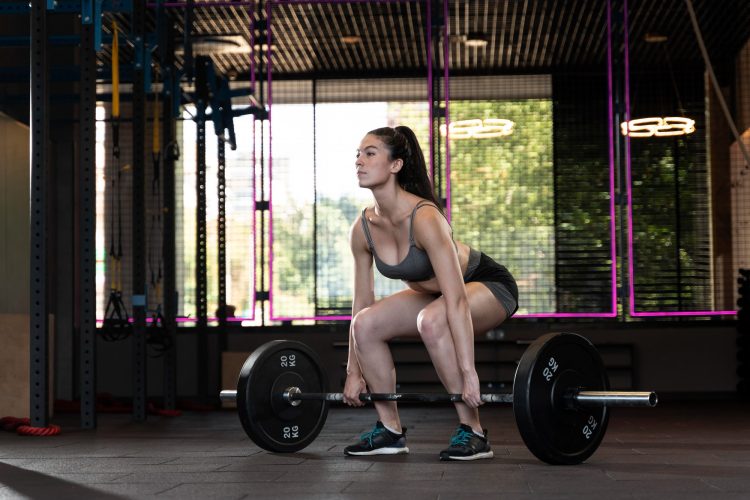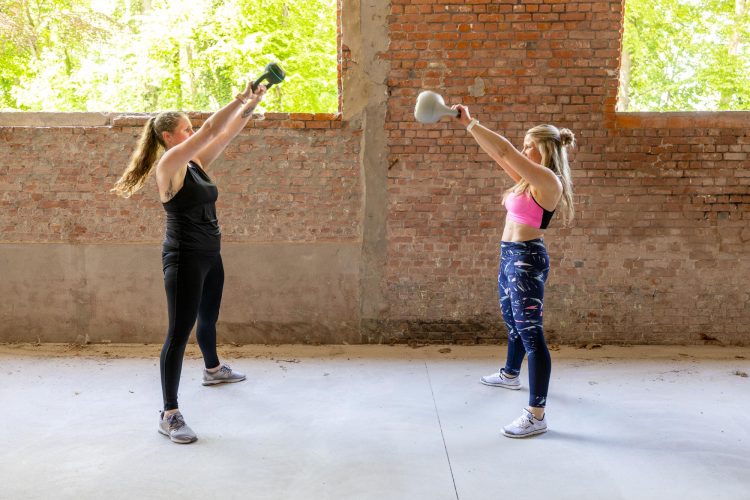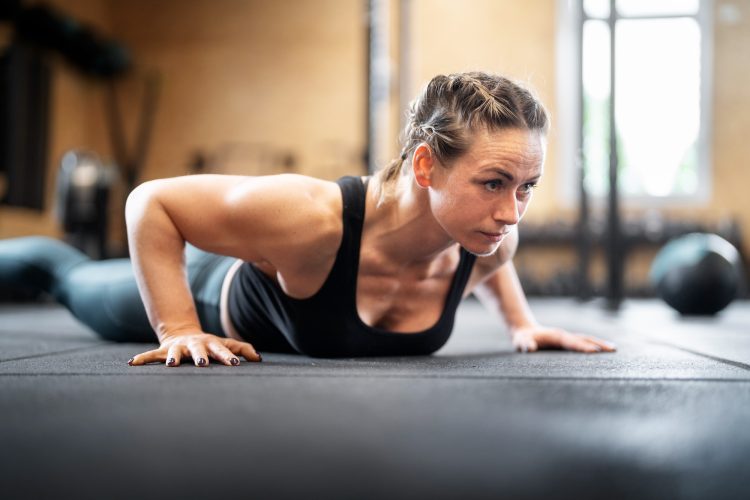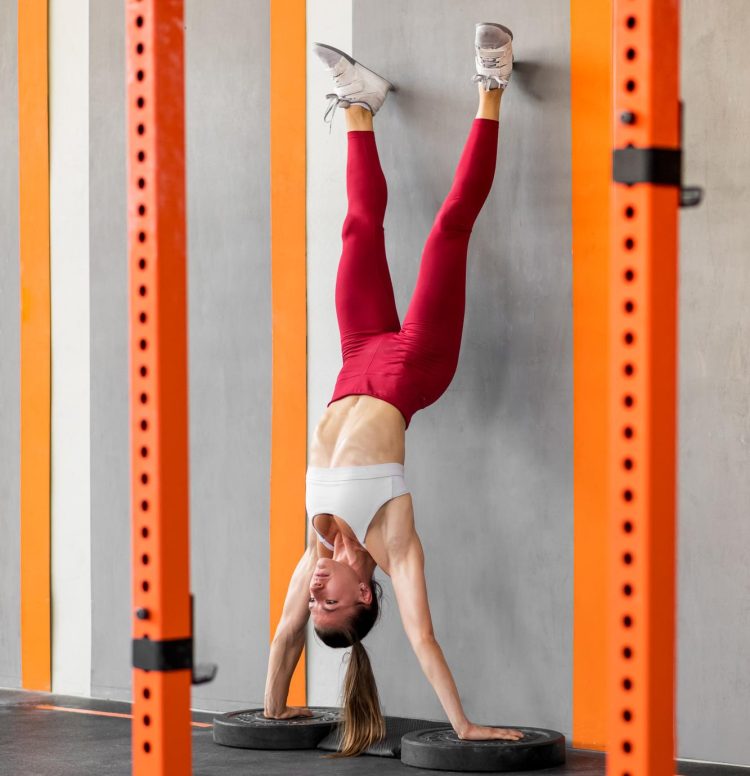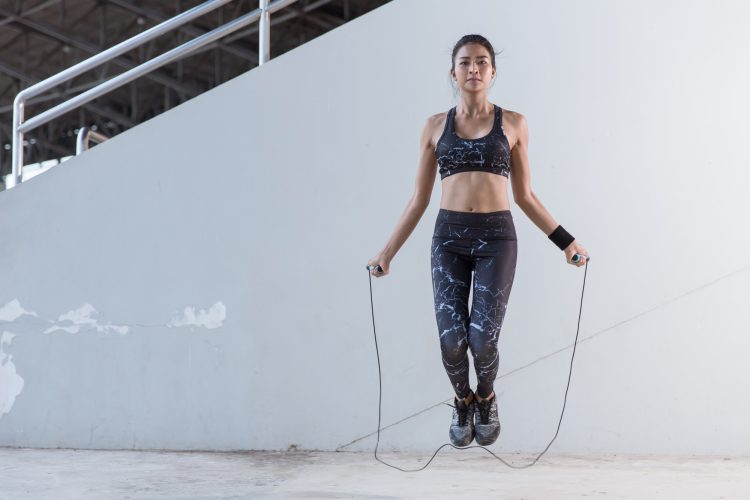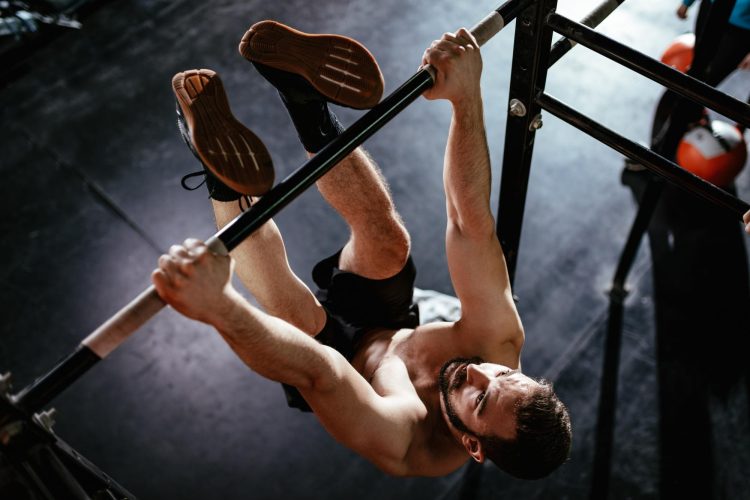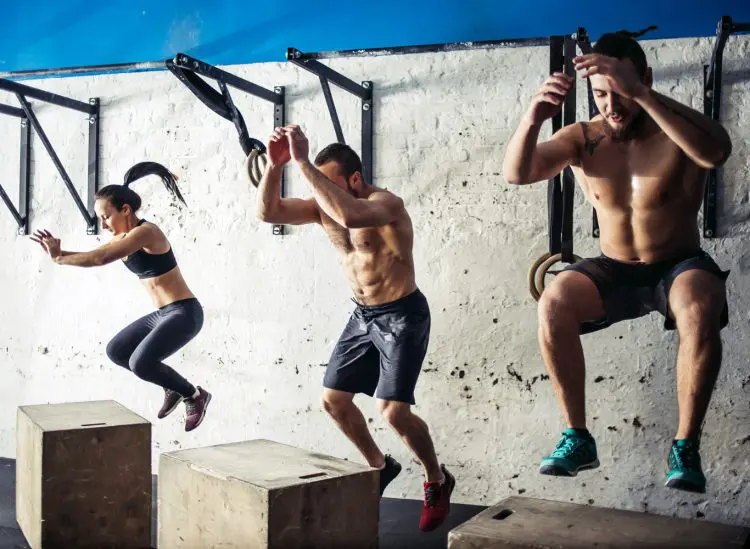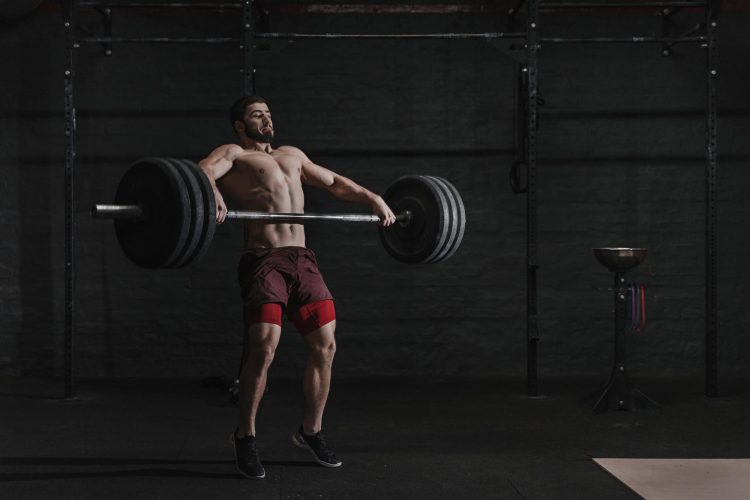CrossFit comprises three modalities — monostructural, gymnastics, and weightlifting. The training methodology is an effective way to get fit but can also improve your sense of community, satisfaction, and motivation. (1)
I have trained in CrossFit and coached the methodology for the last 10 years and have seen the positive impact it can have on people inside and outside the gym. From improving body fat levels to building functional strength and helping people get off medication, almost anyone can benefit from it.
But if you are going to try CrossFit workouts, it is important to know how to modify them to your unique needs. Below are 11 CrossFit coach-approved workouts to get you started, with various ways to scale them up or down based on your abilities.
If you are looking for new workouts, keep reading and give them a shot!
The 11 CrossFit Workouts
Add the following workouts to your programming:
Workout 1: AMRAP 15 minutes
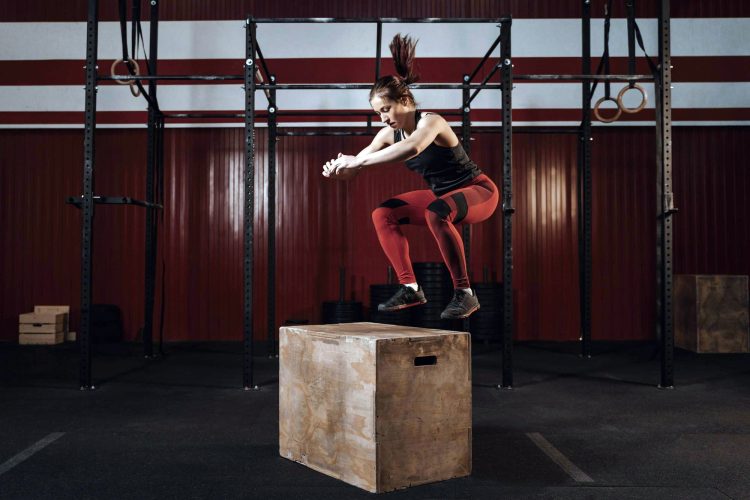
Level Up Your Fitness: Join our 💪 strong community in Fitness Volt Newsletter. Get daily inspiration, expert-backed workouts, nutrition tips, the latest in strength sports, and the support you need to reach your goals. Subscribe for free!
- 15 Wall Balls 20/14 lbs to 10’/9’ target
- 12 Box Jumps 24/20″
- 9 Toes-to-Bar
For this AMRAP (as many rounds as possible) workout, you will perform 15 wall balls, 12 box jumps, and nine toes-to-bar for as many rounds as possible in 15 minutes.
The goal is to move through the rounds and repetitions at a pace you can sustain for 15 minutes. In the first few rounds, it can be easy to think that a faster pace can be maintained. But typically, it is best to pull back and move slower than you think you can to avoid burning out.
How To Scale This Workout
Beginners
- Use a lighter wall ball.
- Decrease the box height.
Advanced
- Use a heavier wall ball.
- Increase the height of the wall ball target.
- Use a bigger box.
Workout 2: For Time — Deadlifts and Handstand Push-ups (Diane)
- 21-15-9
- Deadlifts 225/155 lbs
- Handstand Push-ups
This classic CrossFit “girl” workout packs a serious punch. In this workout, you’ll perform 21 repetitions of deadlifts and handstand push-ups, followed by 15 repetitions and then nine repetitions of each. Your score will be the total time it takes you to complete all required repetitions.
The deadlift activates almost every muscle on the backside of the body (2), But that doesn’t mean it’s not prone to muscle fatigue. If you hit muscle failure, it can take time to regain enough strength to keep moving. Therefore, you want to break before this point and ensure your deadlift technique remains dialed in to avoid injury.
How To Scale This Workout
Beginners
- Decrease load on the deadlifts.
- Change the deadlifts to a kettlebell deadlift.
- Scale the handstand push-ups to conventional push-ups.
- Scale the handstand push-ups to pike push-ups.
Advanced
- Increase the weight on the deadlifts.
- Go unbroken.
- Increase the range of motion of handstand push-ups.
- Add a weighted vest.
Workout 3: Three Rounds for Time (Helen)
- 400m Run
- 21 Kettlebell Swings 53/35 lbs
- 12 Pull-ups
This is another “girl” workout that CrossFitters have been doing for years and is often used to judge progress year to year. For Helen, you’ll perform three rounds as fast as possible of 400-meter runs, 21 kettlebell swings, and 12 pull-ups.
In this workout, it will be best to pace yourself during the first two rounds and then finish strong in the final round. Since this workout starts with a run, you are moving at a sustainable pace. But it is expected to feel that way and then hit muscle fatigue in the arms and back muscles when you get to the pull-ups.
So, you’ll want to break up the kettlebell swings and pull-ups as needed to avoid unnecessary rest breaks and keep your average pace high throughout the workout.
How To Scale This Workout
Beginners
- Shorten the run to 200 meters.
- Use a lighter kettlebell.
- Use a band for the pull-ups or swap for ring rows.
Advanced
- Increase the load on the kettlebell swings.
- Wear a weighted vest.
- Swap the pull-ups for bar muscle-ups.
Workout 4: AMRAP 20 minutes
- 10 Dumbbell Thrusters 50/35 lbs
- 15 Burpees over the Bar
- 20 Double Unders
This is a longer-than-usual CrossFit workout with a 20-minute time domain. In this workout, you’ll perform 10 dumbbell thrusters, 15 burpees over the bar, and 20 double unders as many times as possible in 20 minutes.
Since this is a longer workout and very shoulder intensive, you should pace yourself according to your fitness level.
Typically, I suggest a pace four times the work interval to keep the workout aerobic. So, for this workout, you will move at a pace that you could theoretically hold for a 40-minute “race.”
How To Scale This Workout
Beginners
- Decrease the weight on the dumbbells.
- Perform single unders instead of double unders.
- Perform a burpee step-over instead of a jump-over.
Advanced
- Increase the load on the dumbbells.
- Increase repetitions on the double unders.
Workout 5: For Time — Clean and Jerks, 1-Mile Run, Bar-facing Burpees
- 30 Clean and Jerks 135/95 lbs
- 1-Mile Run
- 50 Bar-facing Burpees
This for-time workout is also long, so pacing will be critical. For this workout, you’ll perform thirty clean and jerks, run one mile, and finish with 50 bar-facing burpees.
The clean and jerks can be a squat or power variation, and you’ll have to jump over the barbell and turn to face the bar on the burpees. Your score will be the total time it takes you to complete the required work.
To maintain your pace in this workout, it will be a good idea to perform single repetitions on the clean and jerk rather than multiple repetitions unbroken. Also, choose a slower pace than what you think you can hold on the run. This way, you can put the gas pedal down on the burpees.
How To Scale This Workout
Beginners
- Decrease the weight on the clean and jerks.
- Shorten the run to 800 meters.
- Perform a step-over instead of a jump for the burpees.
Advanced
- Increase weight on the clean and jerks.
- Increase the number of unbroken repetitions per set.
- Wear a weighted vest.
Workout 6: 2 Rounds for Time
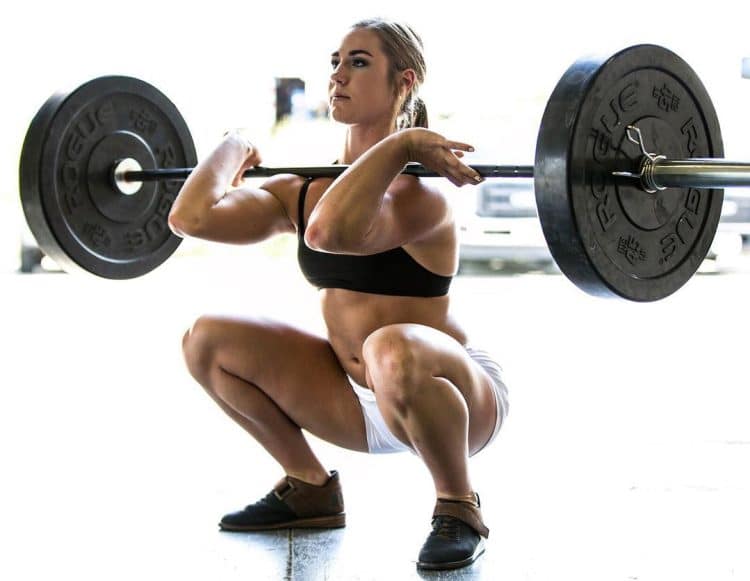
2 Rounds for Time:
- 500m Row
- 20 Front Squats 135/95 lbs
- 20 Pull-ups
This workout is shorter than most CrossFit workouts but will still be challenging. For this workout, you’ll perform two rounds for time of a 500-meter row, 20 front squats, and 20 pull-ups.
Since this workout has only two rounds, you can opt for a faster pace. However, the number of repetitions for the front squats and pull-ups can challenge your muscle endurance. It will be a good idea for this workout to move slower in the first round and then push the pace in the second round.
How To Scale This Workout
Beginners
- Decrease load on front squats.
- Use a band to assist with pull-ups or swap for jumping pull-ups.
Advanced
- Increase load on the front squats.
- Scale the pull-ups to chest-to-bar pull-ups.
Workout 7: AMRAP 12 minutes
- 10 Handstand Push-ups
- 15 Wall Balls 20/14 lbs to 10’/9’ target
- 20 Box Jumps 24/20″
Twelve minutes is an expected time domain for CrossFit athletes competing in the CrossFit worldwide open. If you compete, you can improve your metabolic conditioning to perform for twelve minutes like this workout.
For this workout, you’ll perform as many rounds as possible of ten handstand push-ups, fifteen wall balls, and twenty box jumps. The pace will revolve around maintaining your shoulder muscle endurance for the handstand push-ups.
If your shoulders tend to fatigue quickly, you’ll want to move slower on the wall balls and box jumps to allow recovery between rounds.
How To Scale This Workout
Beginners
- Scale the handstand push-ups to pike push-ups or regular push-ups.
- Decrease weight on the wall balls.
- Decrease the height of the box or wall ball target.
Advanced
- Increase the range of motion of the handstand push-ups.
- Use heavier wall balls.
- Increase the height of the box.
Workout 8: For Time — Double Unders and Abmat Sit-ups (Annie)
Level Up Your Fitness: Join our 💪 strong community in Fitness Volt Newsletter. Get daily inspiration, expert-backed workouts, nutrition tips, the latest in strength sports, and the support you need to reach your goals. Subscribe for free!
For Time:
- 50-40-30-20-10
- Double Unders
- Abmat Sit-ups
Annie is another classic “girl” workout that focuses on abdominal muscle endurance. For the workout, you will perform a descending ladder for time, beginning with 50 repetitions of double unders and ab mat sit-ups followed by 40, 30, 20, and 10 of each.
This workout is technically a sprint to the finish. Still, something to consider is that it involves one hundred and fifty sit-ups. It can be very easy to hit muscle fatigue in the abdomen, which will slow you down.
This will typically happen in the round of 40 or 30. To avoid this, start slower and then pick up the pace.
How To Scale This Workout
Beginners
- Perform single unders instead of double unders.
- Decrease repetitions on the ab mat sit-ups.
Advanced
- Swap ab mat sit-ups for sit-ups on the glute-ham developer device (GHD).
- Use a drag rope or perform triple unders.
Workout 9: 5 Rounds for Time
5 Rounds for Time:
- 200m Run
- 15 Kettlebell Swings 53/35 lbs
- 10 Toes-to-Bar
This workout is similar to the Helen workout; however, it adds another gymnastic movement instead of the pull-ups to challenge your core.
This adds a new challenge since the fatigue in the core from the kettlebell swings will make the toes-to-bar more difficult. Additionally, the added rounds for time for this workout will increase your working duration.
For this workout, you’ll start with a 200-meter run followed by 15 kettlebell swings and 10 toes-to-bar. Done for five rounds for the lowest total time possible.
How To Scale This Workout
Beginners
- Decrease the load on the kettlebell swings.
- Scale the toes-to-bar to knees-to-elbows or knees-to-waist.
Advanced
- Perform a toes-to-bar pull-up
- Increase the load on the kettlebell swings.
- Perform a kettlebell snatch.
Workout 10: AMRAP 18 minutes (12.3)
- 15 Box Jumps 24/20″
- 12 Push-Press 115/75 lbs
- 9 Toes-to-bar
This is a CrossFit Open workout from 2012 and is commonly used as a yearly “tester” to gauge progress year over year. The workout combines three common movements in CrossFit and challenges almost every part of the body. It also has a more extended time domain to challenge your metabolic conditioning.
For this workout, you will perform 15 box jumps, 12 push presses, and nine toes to bar for as many rounds and repetitions as possible. Having done this workout multiple times, I can tell you that the push press is where you will fatigue.
The shoulders are the smallest of all the major muscles used in this workout, so breaking at the halfway mark would be a good way to mitigate this.
How To Scale This Workout
Beginners
- Use a smaller box.
- Decrease the load on the push-press.
- Scale to knees-to-elbows.
Advanced
- Increase the height of the box.
- Increase the weight of the push-press.
Workout 11: For Time — Power Snatches and Overhead Squats
- 21-15-9
- Power Snatches 95/65 lbs
- Overhead Squats 95/65 lbs
The final workout is a short, fast-paced workout that follows the 21, 15, and nine format. You’ll perform a set of required repetitions of both power snatches and overhead squats before moving on to the next round.
This workout only consists of barbell movements, so being aware of the muscle endurance in your legs, shoulders, and grip is crucial to achieving a good time.
An excellent way to attack this workout is to break up each round into manageable sets, such as dropping the bar after 11 reps or breaking up each round into three smaller sets.
How To Scale This Workout
Beginners
- Lower the weight on the barbell.
- Perform kettlebell swings instead of snatches.
- Do front squats instead of overhead squats.
Advanced
- Increase the load on the barbell.
Importance of Proper Scaling
Here are the benefits of adjusting your workouts per your experience level:
Preserve the Stimulus
Knowing how to scale your workouts properly allows you to maximize stimulus.
For example, if the objective of the workout is to train your aerobic system, but the weight of the barbell or dumbbell forces you to stop and rest because it is too heavy, you aren’t training aerobically. By scaling down, you can personalize the workout and maintain the stimulus.
Prevent Injury
Research supports that the injury rate of CrossFit training is no worse and may even be lower than that of other common types of exercise or strength training (3). However, performing workouts that are too advanced for you is one way to increase the likelihood of sustaining an injury.
By scaling the complexity of the movements or the loads you use during your workouts, you can ensure that proper form is adhered to and you don’t develop overuse injuries.
Lack of Skill
Another reason to scale your workouts appropriately is skill progression. It is no secret that CrossFit demands a high level of gymnastic skills within the training methodology, in addition to Olympic weightlifting and powerlifting skills.
The scalability of CrossFit workouts makes it more inclusive so that more than just high-level athletes can benefit from it based on their capabilities. Without the ability to scale, you would end up attempting to perform gymnastic moves that you could not coordinate and lift barbells and dumbbells for which you don’t have the strength.
Not only would this interrupt the benefits of CrossFit training, but it would also put you at risk of missing the intended stimulus and sustaining an injury.
Progression
Knowing how to scale your workouts effectively can also help you make more progress over time by keeping you injury-free and hitting the intended stimulus. Still, it can also give you benchmarks to work off of.
Wrapping Up
The 11 CrossFit workouts are powerful in their ability to test both your mental toughness and your physical capacity. They combine the elements of strength, conditioning, and skill to create the ultimate training methodology.
But, it is important to know how to adapt these kinds of workouts to your individual needs to make long-term progress and prevent injuries in the gym. Using this article as a guide, you can take on these workouts and have everything you need to scale them down if they are too complex.
You can also scale them up if you need to be challenged further. A traditional CrossFit workout can often be made harder simply by pushing your limits and trying to go just a little faster than last time.
Which of these workouts will you try next? Let me know in the comments below.
References:
- Claudino, J. G., Gabbett, T. J., Bourgeois, F., Souza, H. S., Miranda, R. C., Mezêncio, B., Soncin, R., Cardoso Filho, C. A., Bottaro, M., Hernandez, A. J., Amadio, A. C., & Serrão, J. C. (2018). CrossFit Overview: Systematic Review and Meta-analysis. Sports medicine – open, 4(1), 11.
- Martín-Fuentes, I., Oliva-Lozano, J. M., & Muyor, J. M. (2020). Electromyographic activity in deadlift exercise and its variants. A systematic review. PloS one, 15(2), e0229507.
- Klimek, C., Ashbeck, C., Brook, A. J., & Durall, C. (2018). Are Injuries More Common With CrossFit Training Than Other Forms of Exercise?. Journal of sport rehabilitation, 27(3), 295–299.

